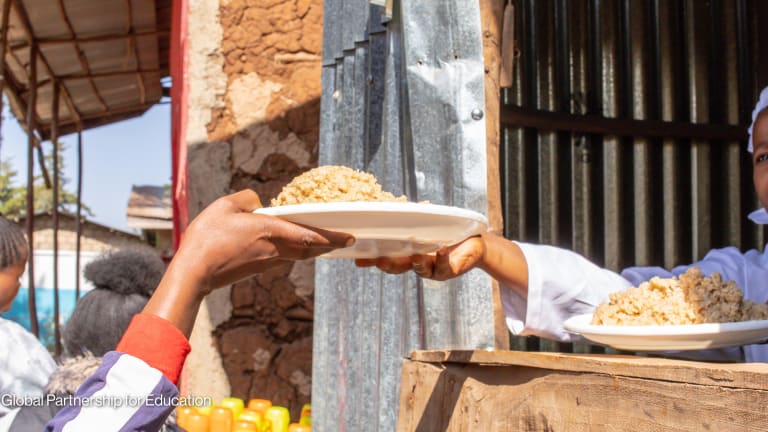
The focus of agricultural policy should be to increase productivity, provide employment and reduce poverty.
How often have you read or heard statements like this?
I am an economist, and I understand this thinking. It has its place. But I will argue that the reason global food systems are failing is because they have neglected the most fundamental purpose of agricultural systems — to nourish people.
Today, more than 2 billion people are suffering from hidden hunger — most will get enough calories, which has been the metric for food systems thus far, but not enough vitamins and minerals. We know too well the global costs of this hidden hunger. We see it in women as they risk death during childbirth. We see it in a stunted child with a diminished IQ. And we see it in men and women too weakened by illness and poor immunity to be able to work at an optimal level.
We need to re-envision agriculture as the primary source of sound nutrition through the food people harvest and eat. This is a radical concept in the true sense of the word — returning to the root or fundamental purpose of agriculture.
See more #FeedingDev articles:
● Let's keep feeding the conversation
● Investing in evidence to end hunger
● Civil society: the ultimate food security tool
Agriculture is adapting to the unprecedented challenge of climate change by becoming climate-smart. The global community is also now calling on agriculture to respond in kind to what the Copenhagen Consensus has twice in the past few years identified as the greatest challenge facing humankind — poor nutrition caused by a lack of vitamins and minerals in the diet.
Agriculture must become nutrition-smart. Nutrition-sensitivity is not enough. Our basic food systems have to be optimized to provide the greatest amount of nutrients per square foot that can be produced sustainably, especially in the face of climate change.
Central to this is dietary diversity. Agricultural systems have favored cereals and grains, and vast productivity increases through numerous green revolutions have provided enough calories to greatly diminish the specter of famine. However, more nutritious foods such as lentils, pulses, vegetables and other orphan crops have not received the same attention; productivity increases have lagged. As prices of these nutritious foods have increased, the poor eat less of them. This is especially evident in South Asia, home to most of the world’s malnourished people. We need to shift away from excessive reliance on monocropped calories by also investing in diverse food systems that integrate staple cereals and grains with other types of nourishing food.
But back to staples. Three crops — wheat, rice and maize — provide most of the world’s calories. We call these types of food staples because they are staples for everyone, irrespective of their income. A rich businesswoman in Singapore eats rice every day, just as a poor farmer in Bangladesh does. But one way we can help the poor farmer, who is more reliant on rice for survival, to improve her family’s nutrition is to make sure the rice that she grows to feed her family and the community is more nutritious.
Since last year, the first high-yielding rice varieties in Bangladesh that are rich in zinc have been made available to farmers. Without enough zinc in their diets, children are at risk of being stunted. Over time, more productive, more climate-smart and more nutrition-smart varieties will be released regularly. In the case of zinc rice, there will soon be varieties that can provide up to 80 percent of an adult woman’s or child’s daily zinc needs, 35 percent more than ordinary rice varieties. Other locally grown food, as well as fortified food and supplements, where available, can make up the difference, but we begin with more nourishing food that is grown at home.
How are crops such as zinc-rice developed? The process is not magic and it is not new. Nutrition-smart plant breeders scour seed banks for neglected and underused varieties that are more nutritious, but that have been passed over in the search for higher yields. Using tried and tested conventional breeding methods, they cross these underused varieties with the most popular high-yielding varieties that farmers grow. From the progeny of the cross-bred varieties, the best varieties are then selected. Nutrition-smart plant breeders also work with nutritionists to determine the nutrient levels that must be bred into these new varieties to have a measurable impact on improving nutrition and public health. There is evidence that they work.
Nutrition-smart food crops are being evaluated or have been released in more than 30 countries. My own program, HarvestPlus, has partnered across sectors to release these crops in seven countries. These crops are released as public goods so they are accessible to poor farmers. Furthermore, we are multiplying and delivering these crops to farmers, working with both private and public sector partners to educate farmers and consumers, and to build markets for these foods. Since orange sweet potato was first released about seven years ago, more than 1.5 million farming families have adopted this and other nutrition-smart crops. Policymakers from around the world met in Kigali this past April and made a commitment to scale up these types of nutritious food. By forging new partnerships across sectors, HarvestPlus and its partners aim to reach more than 100 million people with nutrition-smart crops by 2018.
A few months ago, I traveled to Uganda with journalist Roger Thurow, where I met some “biofortified babies.” Their mothers had been educated on the benefits of orange sweet potato (OSP) over white and yellow ones. These nutrition-smart mothers knew what vitamin A is and why it is crucial to their children’s health. They knew that an ice cream-size scoop of OSP could provide their children with their full daily vitamin A needs. They grew OSP alongside traditional varieties and other food crops and also knew that mangoes, leafy greens and other types of food are good sources of vitamin A. Their awareness and consumption of more nutritious food has increased. And the most important outcome? They have better nourished and healthier babies and children. This is what we are after.
Want to learn more? Check out Feeding Development's campaign site and tweet us using #FeedingDev.
Feeding Development is an online conversation hosted by Devex in partnership with ACDI/VOCA, Chemonics, Fintrac, GAIN, Nestlé and Tetra Tech to reimagine solutions for a food-secure future from seed and soil to a healthy meal.








